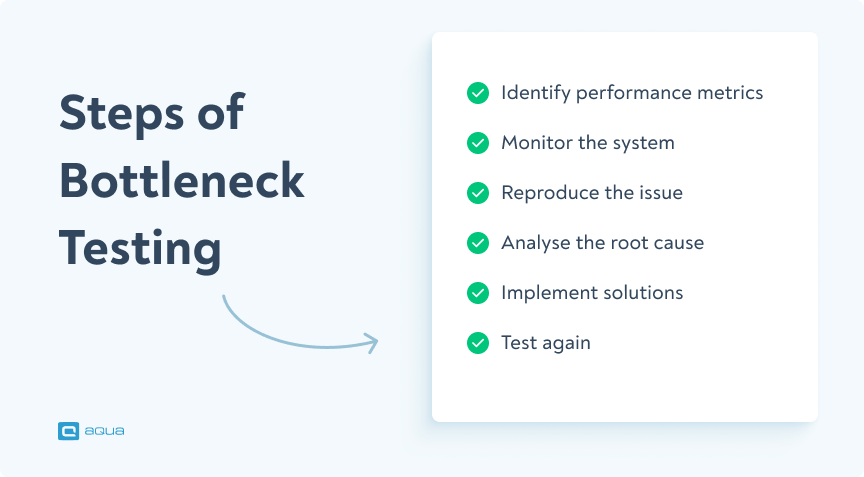What is Bottleneck Testing?
Bottleneck testing is the process of identifying the exact points in a system where performance slows down or stalls. In simple terms, it’s like finding the weakest link in a chain. This is where your application struggles to keep up, and has delays that affect the whole process.
In software testing, bottleneck testing is essential for pinpointing the areas where your application’s speed or stability worsens under stress. This happens especially when handling high loads or complex operations.
Let me give you an example. A well-known study from Fleexy found that a mere one-second delay in page load times can reduce conversions by up to 7%, while a 3 3-second delay results in 53% of mobile users leaving the page. This showcases the massive impact bottlenecks can have on user satisfaction and business outcomes. Sometimes seemingly little problems will cost you a lot, and you won’t even feel it unless you carry out a complete bottleneck testing.
However, bottleneck testing is not just about load testing or stress testing. While those approaches focus on how much your system can handle, bottleneck testing also drills down into why and where the slowdowns happen. As a result, you can target and fix specific problem areas rather than throwing resources at the entire system.
But how does this process benefit you? Let’s break them down in the following section.
I say an hour lost at a bottleneck is an hour out of the entire system. I say an hour saved at a non-bottleneck is worthless.
Benefits of Bottleneck Testing
Bottleneck testing offers powerful advantages that directly impact your application’s (or website’s) success. Let’s break down each one so you can see how it all fits into your testing strategy:
- Improves user experience – Imagine a user tries to navigate your app (or a system), but key features like search or checkout take forever to respond. Frustrating, right? Bottleneck testing helps eliminate those long load times. This results in smoother, faster interactions, which keeps users engaged and satisfied.
- Reduces system downtime – System crashes or slowdowns can hit at the worst times, like during peak traffic or crucial events. By identifying and fixing bottlenecks early, you reduce the risk of downtime. This way, you ensure your system runs smoothly even under pressure.
- Increases scalability – As your user base grows, your system needs to keep up. Bottleneck testing allows you to see how your app or website behaves under increasing loads. For example, if your server is struggling when traffic doubles, bottleneck testing helps you find the issue and scale up before it becomes a real problem.
- Saves money – Performance issues can lead to expensive fixes or lost revenue. For instance, if an e-commerce site is too slow, customers might abandon their carts. Bottleneck testing prevents these losses by catching issues early, saving you money and protecting your bottom line.
- Boosts performance under pressure – Think of major sales events like Black Friday. During peak traffic, your system is pushed to its limits. Bottleneck testing prepares your app to handle these high-pressure moments, so it stays fast and reliable when it counts the most.
So bottleneck testing is essential for identifying slow points in your system, helping you optimise performance and avoid costly delays. But pinpointing these bottlenecks in software testing is only part of the equation—what comes next is just as crucial. To truly capitalise on bottleneck testing, you need a robust Test Management System (TMS) that integrates seamlessly with your software testing efforts.
That is where aqua cloud steps in. With aqua, bottleneck testing becomes more than just identifying performance issues—it’s about addressing them with precision and speed. aqua’s centralised repository combines your manual and automated efforts together, and every team member gains access to real-time data for swift resolution. aqua’s AI helps you generate test cases, test data, and requirements in just 3 clicks, helping you focus on bottlenecks more effectively. Also, aqua’s 100% traceability and visibility provide you full transparency and the opportunity to track every requirement to its source. Plus, with KPI alerts, you’ll be able to prioritise and resolve the bottlenecks faster than ever. aqua’s 1-click bug-recording integration Capture will complete your detective work, identifying the bugs and having visual proof for each one of them, effortlessly.
Carry out efficient bottleneck testing with 100% AI-powered TMS
Steps of Bottleneck Testing
Now, let’s walk through the process of bottleneck testing step by step. Each one is designed to help you track down and fix performance issues.
- Identify performance metrics – First, you need to know what you’re testing for. Are you measuring response time? Throughput? Resource usage? Set clear, specific goals so you can measure how well your system is performing and what success looks like.
- Monitor the system – This is where tools come in handy. Use performance monitoring software to continuously track your application’s behaviour. Keep an eye on key areas like CPU usage, memory, and network traffic. Monitoring gives you a snapshot of where the bottlenecks might be forming.
- Reproduce the issue – Once you’ve spotted a slowdown, try to recreate the conditions that caused it. Maybe it’s a spike in traffic or a resource-heavy task. Reproducing the issue helps you understand the exact circumstances that lead to the bottleneck.
- Analyse the root cause – Now it’s time to dig deeper. Is your database query taking too long? Is there a server that’s overloaded? This is where you pinpoint the exact cause of the problem. For example, if your database query is taking 5 seconds to return, you’ve found a critical bottleneck.
- Implement solutions – With the cause identified, you can now fix the issue. This could mean optimising inefficient code, upgrading hardware, or adjusting configurations. Let’s say your server’s CPU is maxing out during traffic spikes; you might need to add more servers to distribute the load.
- Test again – Once you’ve applied a solution, it’s crucial to test again. Run the same load or conditions to make sure the bottleneck is really gone. If it’s resolved, great! If not, you might need to go back and adjust your solution.

Ready to carry out this process? Now let’s look at the best solutions you can have to complete the process perfectly.
In most organisations, the bottleneck is at the top of the bottle
Ever wondered how a single slow component can bring down your entire system? This interactive pipe simulator lets you create bottlenecks with a simple slider and watch in real-time as data requests pile up, performance crashes, and your system goes from smooth operation to complete failure.
Best Tools and Software for Bottleneck Testing
Generally, the list should contain performance and load testing tools, specifically designed for the mentioned purposes. But we start the list with a tool that goes beyond this, streamlining your whole testing efforts and still being the bottleneck testing ally.
- aqua: While aqua isn’t specifically designed for performance testing, it plays a crucial role in identifying bottlenecks through its comprehensive TMS. Its centralised platform combines both manual and automated tests, giving your team full visibility over the testing process. aqua’s 100% traceability helps you track issues back to their source, making it easier to pinpoint where slowdowns occur. aqua’s KPI alerts and 1-click bug-recording integration, Capture, allow you to quickly document and address bottlenecks with visual evidence, keeping your app running smoothly. aqua also has an amazing AI Copilot, helping you deal with the mentioned bottlenecks. Speaking of AI, 97% time saving is no longer a dream: you’ll automate generating requirements, test cases, and test data, and as a result, you will have more availability to identify bottlenecks and root causes in your systems. So what are you waiting for?
Prioritise bottlenecks with 100% AI-powered TMS
- Apache JMeter
A widely-used open-source performance testing tool, Apache JMeter specialises in performance and load testing. It enables you to simulate heavy traffic on your servers or applications. Its ability to generate detailed reports on system behaviour under stress makes it a go-to for spotting performance bottlenecks, particularly in web apps and databases. - New Relic
New Relic offers real-time application performance monitoring (APM), making it easy to track down bottlenecks within your infrastructure. By visualising performance metrics across your entire stack—from backend to frontend—it provides detailed insights to help you resolve slowdowns, improve user experience, and optimise system performance. - Dynatrace
Known for its AI-powered analytics, Dynatrace monitors your entire application environment to automatically identify bottlenecks and root causes. Its AI continuously analyses data, alerting you to performance issues before they affect your users. Whether it’s infrastructure problems or inefficient code, Dynatrace helps you stay proactive in fixing bottlenecks. - LoadRunner
LoadRunner is perfect for stress-testing your application under heavy loads. It simulates thousands of virtual users interacting with your system, allowing you to identify bottlenecks in high-traffic scenarios. LoadRunner’s detailed reporting provides insights into where your system might falter, helping you improve performance before issues impact your users.
Equipped with these solutions, you can confidently tackle performance issues and eliminate bottlenecks before they impact your users. But if you need to go beyond performance issues and maximise the power of software testing throughout your whole software development lifecycle, you should definitely opt for solutions like aqua.
Conclusion
Let’s wrap it up this way: bottlenecks, when not addressed properly, can turn into huge headaches. The benefits bottleneck testing brings go far beyond fixing performance or load issues. It is a systematic approach that requires strategic planning, prioritisation, and careful evaluation. And of course, you need the right solutions beside you, like aqua cloud. If you are ready to streamline your software testing efforts, not only performance issues, just contact us and let us deal with it.


















